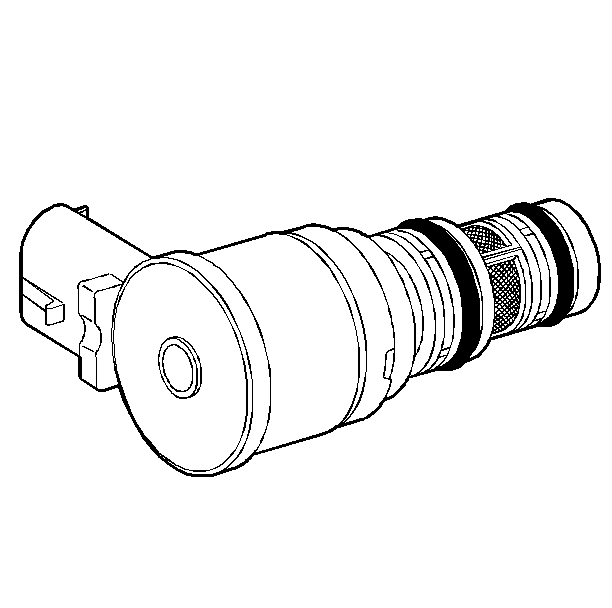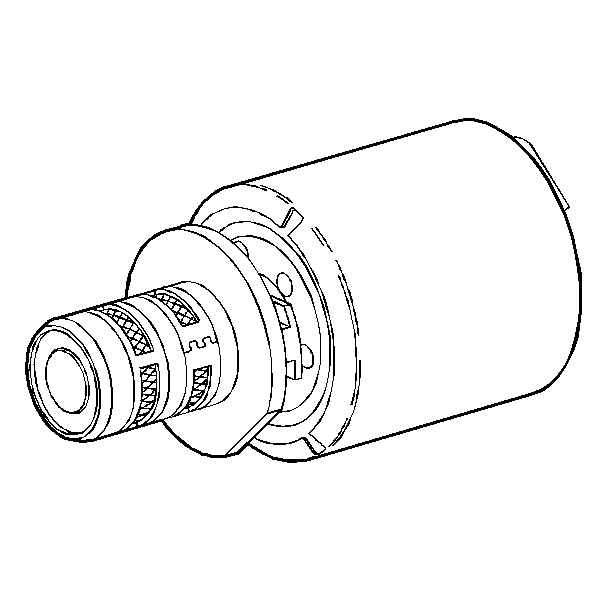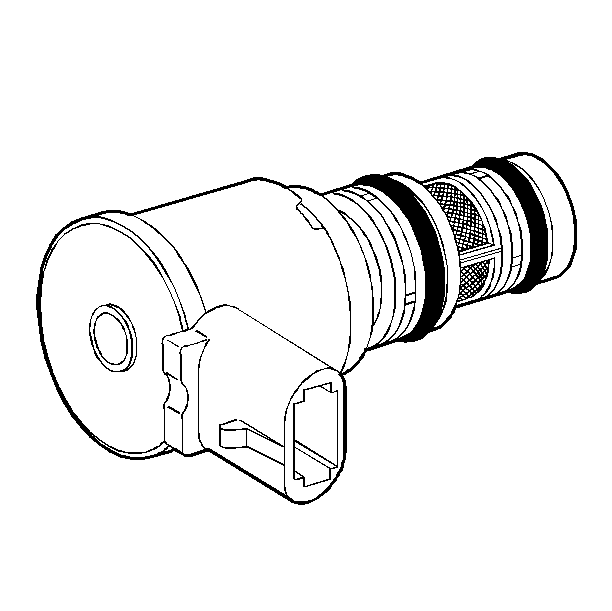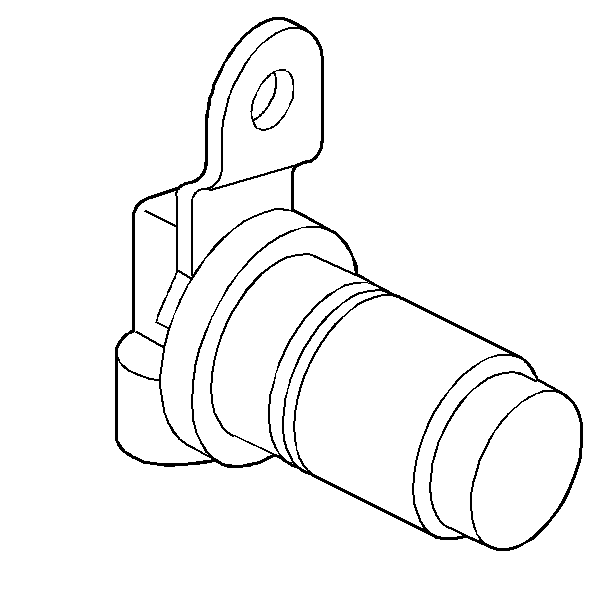1-2 and 2-3 Shift Solenoid Valves

Important: The shift solenoid valve resistance should measure 19-24 ohms minimum when measured at 20°C (68°F). The shift solenoid current flow should not exceed 0.75 amps. The shift solenoid should energize at a voltage of 7.5 volts or more (measured across the terminals). The shift solenoid should de-energize when the voltage is one volt or less.
If both solenoids lose power, third gear only results.The 1-2 and 2-3 shift solenoid valves (also called A and B solenoids) are identical devices that control the movement of the 1-2 and 2-3 shift valves (the 3-4 shift valve is not directly controlled by a shift solenoid). The solenoids are normally open exhaust valves that work in four combinations to shift the transmission into different gears.
The PCM energizes each solenoid by grounding the solenoid through an internal quad driver. This sends current through the coil winding in the solenoid and moves the internal plunger out of the exhaust position. When ON, the solenoid redirects fluid to move a shift valve.
Important: The manual valve hydraulically can override the shift solenoids. Only in D4 do the shift solenoid states totally determine what gear the transmission is in. In the other manual valve positions, the transmission shifts hydraulically and the shift solenoid states CATCH UP when the throttle position and the vehicle speed fall into the correct ranges. Diagnostic trouble codes P0753 and P0758 indicate shift solenoid circuit voltage faults.
The PCM-controlled shift solenoids eliminate the need for TV and governor pressures to control shift valve operation.
3-2 Shift Solenoid Valve Assembly

Important: The 3-2 shift solenoid valve assembly resistance should be a minimum of 20-24 ohms at 20°C (68°F).
The 3-2 shift solenoid valve assembly is an ON/OFF solenoid that is used in order to improve the 3-2 downshift. The solenoid regulates the release of the 3-4 clutch and the 2-4 band apply.
If a voltage fault is detected in the 3-2 shift solenoid circuit, diagnostic trouble code P0785 will set.
Transmission Pressure Control Solenoid

Important: Transmission pressure control solenoid resistance should measure 3-5 ohms when measured at 20°C (68°F).
The transmission pressure control solenoid is an electronic pressure regulator that controls pressure based on the current flow through its coil winding. The magnetic field produced by the coil moves the solenoid's internal valve which varies pressure to the pressure regulator valve.
The PCM controls the pressure control solenoid by commanding current between 0.1 and 1.1 amps. This changes the duty cycle of the solenoid, which can range between 5 percent and 95 percent (typically less than 60 percent). 1.1 amps corresponds to minimum line pressure, and 0.1 amps corresponds to maximum line pressure (if the solenoid loses power, the transmission defaults to maximum line pressure).
The PCM commands the line pressure values, using inputs such as the throttle position sensor.
The pressure control solenoid takes the place of the throttle valve or the vacuum modulator that was used on the past model transmissions.
If the duty cycle drops below 5 percent or rises above 95 percent, DTC P0748 will set.
Torque Converter Clutch Solenoid Valve

Important: The TCC solenoid resistance should be 21-26 ohms minimum when measured at 20°C (68°F).
If a fault is detected in the TCC solenoid circuit, code P0740 will set.
The torque converter clutch solenoid valve is a normally open exhaust valve that is used to control torque converter clutch apply and release. When grounded (energized) by the PCM, the TCC solenoid valve stops converter signal oil from exhausting. This causes converter signal oil pressure to increase and shifts the TCC solenoid valve into the apply position.
The brake switch is an input to the PCM, and the PCM directly controls the TCC apply based on the brake switch status.
Torque Converter Clutch PWM Solenoid Valve

Important: TCC PWM solenoid valve resistance should be 10-11 ohms when measured at 20°C (68°F), and 13-15 ohms when measured at 100°C (212°F).
The torque converter clutch PWM solenoid valve controls the fluid acting on the converter clutch valve, which then controls the TCC apply and release. This solenoid is attached to the control valve body assembly within the transmission. The TCC PWM solenoid valve provides smooth engagement of the torque converter clutch by operating on a negative duty cycle a variable percent of ON time.
If a fault is detected in the TCC PWM circuit, code P1860 will set.
Transmission Fluid Pressure (TFP) Manual Valve Position Switch

Important: Seven valid combinations and two invalid combinations are available from the TFP manual valve position switch. Refer to the Transmission Fluid Pressure (TFP) Manual Valve Position Switch Logic table for valid/invalid combinations for range signal circuits A, B and C.
The transmission fluid pressure (TFP) manual valve position switch is a set of five pressure switches on the control valve body that sense whether fluid pressure is present in five different valve body passages. The combination of which switches are open and closed is used by the PCM in order to determine actual manual valve position. The TFP manual valve position switch, however, cannot distinguish between PARK and NEUTRAL because the monitored valve body pressures are identical in both cases.
The switches are wired to provide three signal lines that are monitored by the PCM. These inputs are used to help control line pressure, torque converter clutch apply and shift solenoid valve operation. Voltage at each of the signal lines is either zero or twelve volts.
In order to monitor the TFP manual valve position switch operation, the PCM compares the actual voltage combination of the switches to a TFP combination table stored in its memory. If the PCM sees one of two illegal voltage combinations, a DTC P1810 will result. A DTC P1810 indicates a short circuit condition in either the range signal A or the range signal C circuits.
The TFP manual valve position switch signal voltage can be measured from each pin-to-ground and compared to the combination table. On the automatic transmission (A/T) wiring harness assembly, pin N is range signal A, pin R is range signal B, and pin P is range signal C. With the A/T wiring harness assembly connected and the engine running, a voltage measurement of these three lines will indicate a high reading (near 12 volts) when a circuit is open, and a low reading (zero volts) when the circuit is switched to ground.
The transmission fluid temperature (TFT) sensor is part of the TFP manual valve position switch assembly.
Vehicle Speed Sensor

Important: The sensor resistance is model dependent and varies with speed from a minimum of 0.5 volts AC at 100 RPM to more than 100 volts AC at 8000 RPM.
The vehicle speed sensor (or transmission output speed sensor) controls shift points and calculates the TCC slip.
The speed sensor contains a coil that gives off a continuous magnetic field. A rotor rotates past the sensor and the rotor teeth break the magnetic field. Each break in the field sends a pulse to the VSSB (Vehicle Speed Sensor Buffer). The VSSB sends two signals to the PCM. The first is a 2002 pulse per mile (PPM) signal that is used by the engine. The second is the transmission/transfer case 40 pulse per revolution (PPR) signal that is used in order to control the transmission.
In two wheel drive (2WD) applications, the vehicle speed sensor is located on the transmission extension housing. Trans Output Speed = Transfer Case Speed.
DTC P0502 will set if a fault exists in the vehicle speed sensor circuit 40 PPR line.
Automatic Transmission Fluid Temperature Sensor
The automatic transmission fluid temperature (TFT) sensor is part of the automatic transmission fluid pressure (TFP) manual valve position switch assembly. This sensor helps control torque converter clutch apply and shift quality.
The TFT sensor is a resistor, or thermistor, which changes value based on temperature. At low temperatures the resistance is high, and at high temperatures the resistance is low.
The PCM sends a 5 volt signal to the TFT sensor and the PCM measures the voltage drop in the circuit. You will measure a high voltage when the transmission is cold and a low voltage when the transmission is hot. Refer to the Temperature vs Resistance table.
If the TFT sensor circuit has a fault, DTC P0712 or P0713 is set. A DTC P0712 indicates a short circuit condition, while a DTC P0713 indicates an open circuit condition. DTC P0218 is set if the transmission is operating at a high temperature for a period of time.
